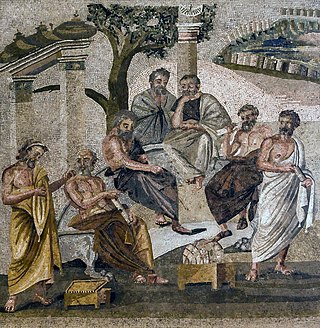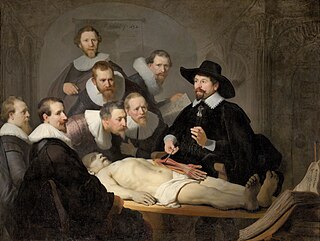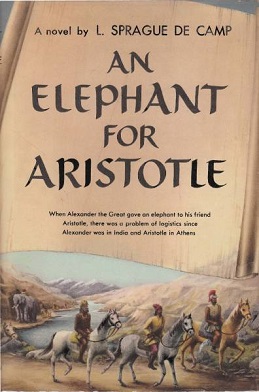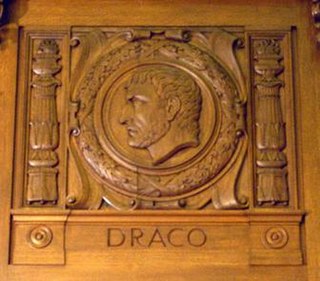
Aristotle was an Ancient Greek philosopher and polymath. His writings cover a broad range of subjects including physics, biology, zoology, metaphysics, logic, ethics, aesthetics, poetry, drama, music, rhetoric, psychology, linguistics, economics, politics, meteorology, geology, and government. As the founder of the Peripatetic school of philosophy in the Lyceum in Athens, he began the wider Aristotelian tradition that followed, which set the groundwork for the development of modern science.

Anaxagoras was a Pre-Socratic Greek philosopher. Born in Clazomenae at a time when Asia Minor was under the control of the Persian Empire, Anaxagoras came to Athens. According to Diogenes Laërtius and Plutarch, in later life he was charged with impiety and went into exile in Lampsacus; the charges may have been political, owing to his association with Pericles, if they were not fabricated by later ancient biographers.
A sophist was a teacher in ancient Greece in the fifth and fourth centuries BC. Sophists specialized in one or more subject areas, such as philosophy, rhetoric, music, athletics, and mathematics. They taught arete – "virtue" or "excellence" – predominantly to young statesmen and nobility.

Cleisthenes, or Clisthenes, was an ancient Athenian lawgiver credited with reforming the constitution of ancient Athens and setting it on a democratic footing in 508 BC. For these accomplishments, historians refer to him as "the father of Athenian democracy." He was a member of the aristocratic Alcmaeonid clan. He was the younger son of Megacles and Agariste making him the maternal grandson of the tyrant Cleisthenes of Sicyon. He was also credited with increasing the power of the Athenian citizens' assembly and for reducing the power of the nobility over Athenian politics.

The Peripatetic school was a school of philosophy in Ancient Greece. Its teachings derived from its founder, Aristotle, and peripatetic is an adjective ascribed to his followers.

Ancient Greek literature is literature written in the Ancient Greek language from the earliest texts until the time of the Byzantine Empire. The earliest surviving works of ancient Greek literature, dating back to the early Archaic period, are the two epic poems the Iliad and the Odyssey, set in an idealized archaic past today identified as having some relation to the Mycenaean era. These two epics, along with the Homeric Hymns and the two poems of Hesiod, Theogony and Works and Days, constituted the major foundations of the Greek literary tradition that would continue into the Classical, Hellenistic, and Roman periods.

The Academy was founded by Plato in c. 387 BC in Athens. Aristotle studied there for twenty years before founding his own school, the Lyceum. The Academy persisted throughout the Hellenistic period as a skeptical school, until coming to an end after the death of Philo of Larissa in 83 BC. The Platonic Academy was destroyed by the Roman dictator Sulla in 86 BC.

The Anatomy Lesson of Dr. Nicolaes Tulp is a 1632 oil painting on canvas by Rembrandt housed in the Mauritshuis museum in The Hague, the Netherlands. The painting is regarded as one of Rembrandt's early masterpieces.

Rembrandt Harmenszoon van Rijn, usually simply known as Rembrandt, was a Dutch Golden Age painter, printmaker and draughtsman. An innovative and prolific master in three media, he is generally considered one of the greatest visual artists in the history of art and the most important in Dutch art history.

An Elephant for Aristotle is a 1958 historical novel by American writer L. Sprague de Camp. It was first published in hardback by Doubleday, and in paperback by Curtis in 1971. The first British edition was published by Dobson in 1966. The book was reissued with a new introduction by Harry Turtledove as a trade paperback and e-book by Phoenix Pick in March 2013. It is the first of de Camp's historical novels in order of writing, and the third chronologically.

Pisistratus or Peisistratus was a politician in ancient Athens, ruling as tyrant in the late 560s, the early 550s and from 546 BC until his death. His unification of Attica, the triangular peninsula of Greece containing Athens, along with economic and cultural improvements laid the groundwork for the later preeminence of Athens in ancient Greece. His legacy lies primarily in his institution of the Panathenaic Games, historically assigned the date of 566 BC, and the consequent first attempt at producing a definitive version of the Homeric epics. Peisistratos' championing of the lower class of Athens is an early example of populism. While in power, he did not hesitate to confront the aristocracy and greatly reduce their privileges, confiscating their lands and giving them to the poor. Peisistratos funded many religious and artistic programs, in order to improve the economy and spread the wealth more equally among the Athenian people.

Aristotle with a Bust of Homer, also known as Aristotle Contemplating a Bust of Homer, is an oil-on-canvas painting by Rembrandt that depicts Aristotle wearing a gold chain and contemplating a sculpted bust of Homer. It was created as a commission for Don Antonio Ruffo's collection. It was bought and sold by several collectors until it was eventually purchased by the Metropolitan Museum of Art. The mysterious tone in the painting has led several scholars to different interpretations of Rembrandt's theme.

Fourteen Rembrandt paintings are held in collections in Southern California. This accumulation began with J. Paul Getty's purchase of the Portrait of Marten Looten in 1938, and is now the third-largest concentration of Rembrandt paintings in the United States. Portrait of Marten Looten is now housed at the Los Angeles County Museum of Art (LACMA).

Comedy is a genre of fiction that consists of discourses or works intended to be humorous or amusing by inducing laughter, especially in theatre, film, stand-up comedy, television, radio, books, or any other entertainment medium. The term originated in ancient Greece: In Athenian democracy, the public opinion of voters was influenced by political satire performed by comic poets in theaters. The theatrical genre of Greek comedy can be described as a dramatic performance pitting two groups, ages, genders, or societies against each other in an amusing agon or conflict. Northrop Frye depicted these two opposing sides as a "Society of Youth" and a "Society of the Old". A revised view characterizes the essential agon of comedy as a struggle between a relatively powerless youth and the societal conventions posing obstacles to his hopes. In this struggle, the youth then becomes constrained by his lack of social authority, and is left with little choice but to resort to ruses which engender dramatic irony, which provokes laughter.

The Lyceum was a temple dedicated to Apollo Lyceus.

The Polish Rider is a seventeenth-century painting, usually dated to the 1650s, of a young man traveling on horseback through a murky landscape, now in The Frick Collection in New York. When the painting was sold by Zdzisław Tarnowski to Henry Frick in 1910, there was consensus that the work was by the Dutch painter Rembrandt. This attribution has since been contested, though those who contest it remain in the minority.
Richard Charles Murray Janko is an Anglo-American classical scholar and the Gerald F. Else Distinguished University Professor of Classical Studies at the University of Michigan.

The Draconian constitution, or Draco's code, was a written law code enforced by Draco in Athens near the end of the 7th century BC; its composition started around 621 BC. It was written in response to the unjust interpretation and modification of oral law by Athenian aristocrats. As most societies in Ancient Greece codified basic law during the mid-seventh century BC, Athenian oral law was manipulated by the aristocracy until the emergence of Draco's code. Around 621 BC the people of Athens commissioned Draco to devise a written law code and constitution, giving him the title of the first legislator of Athens. The literate could read the code at a central location accessible to anyone. This enactment of a rule of law was an early manifestation of Athenian democracy.

Slavery was an accepted practice in ancient Greece, as in other societies of the time. Some Ancient Greek writers described slavery as natural and even necessary. This paradigm was notably questioned in Socratic dialogues; the Stoics produced the first recorded condemnation of slavery.

Athenian democracy developed around the 6th century BC in the Greek city-state of Athens, comprising the city of Athens and the surrounding territory of Attica. Although Athens is the most famous ancient Greek democratic city-state, it was not the only one, nor was it the first; multiple other city-states adopted similar democratic constitutions before Athens. By the late 4th century BC as many as half of the over one thousand existing Greek city-states might have been democracies.


















